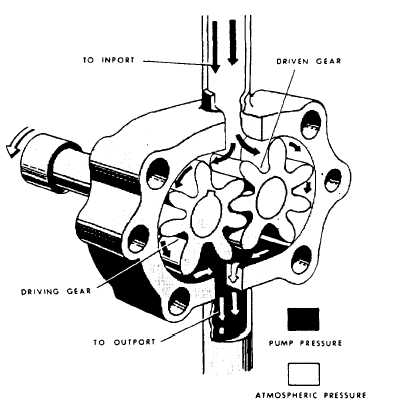at a given speed and (2) variable delivery when running at a given speed.
Pumps may further be divided into types, based upon the design used to create force (fluid flow). Practically all hydraulic pumps fall within three classifications of design-rotary, reciprocating, and centrifugal. The centrifugal style pumps find little use in CESE hydraulic systems used in the Naval Construction Force and will not be covered here. Pumps may be driven by air pressure, electric motors, gas turbine engines, or the conventional internal combustion engines (gasoline and diesel).
Rotary Pumps
All rotary pumps operate by means of rotating parts, that trap the fluid at the inlet (suction) port and force it through the discharge port into the hydraulic system. Gears, lobes, and vanes are commonly used as elements in rotary pumps. Rotary pumps operate on the positive displacement principle and are of the fixed displacement type.
There are numerous types of rotary pumps and various methods of classification. They may be classified as to shaft position - either vertically or horizontally mounted; the type of drive-electric motor, internal combustion engine, and so forth; manufacturer's name; or service application; however, classification of rotary pumps is generally made according to the type of rotating element. A few of the most common types of rotary pumps are covered in the paragraphs below.
GEAR PUMP. - Gear pumps are classified by their method of meshing together. This style pump is simple in design and finds wide use in low-pressure hydraulic systems. A gear pump delivers a constant volume of fluid at any given rpm (fig. 10-3).
The pump shown is known as a spur tooth and consists of two meshed gears that revolve alongside each other in one housing. The drive gear in the illustration is turned by a drive shaft that engages the power source. The clearances between the gear teeth, as they mesh, and the pump housing are very small.

Figure 10-3.-Typical gear type of hydraulic pump.
Continue Reading